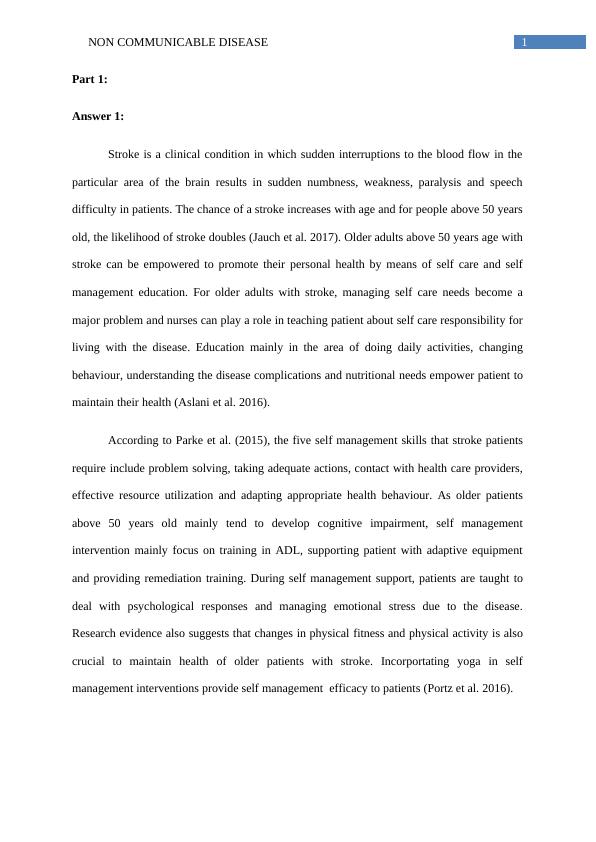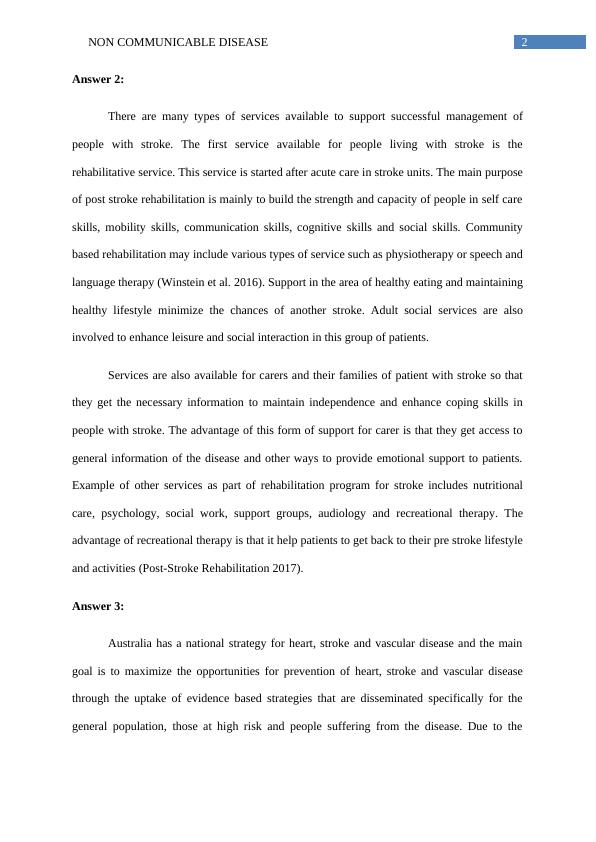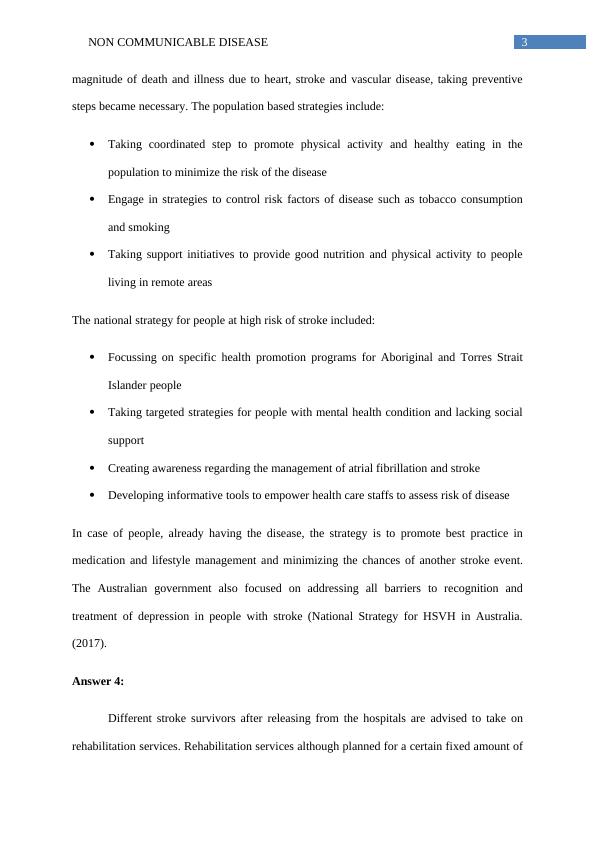Ask a question from expert
Study on Non Communication Disease
12 Pages2852 Words128 Views
Added on 2020-05-04
Study on Non Communication Disease
Added on 2020-05-04
BookmarkShareRelated Documents
Running head: NON COMMUNICABLE DISEASENon communicable diseaseName of the student:Name of the University:Author’s note

1NON COMMUNICABLE DISEASEPart 1:Answer 1: Stroke is a clinical condition in which sudden interruptions to the blood flow in theparticular area of the brain results in sudden numbness, weakness, paralysis and speechdifficulty in patients. The chance of a stroke increases with age and for people above 50 yearsold, the likelihood of stroke doubles (Jauch et al. 2017). Older adults above 50 years age withstroke can be empowered to promote their personal health by means of self care and selfmanagement education. For older adults with stroke, managing self care needs become amajor problem and nurses can play a role in teaching patient about self care responsibility forliving with the disease. Education mainly in the area of doing daily activities, changingbehaviour, understanding the disease complications and nutritional needs empower patient tomaintain their health (Aslani et al. 2016). According to Parke et al. (2015), the five self management skills that stroke patientsrequire include problem solving, taking adequate actions, contact with health care providers,effective resource utilization and adapting appropriate health behaviour. As older patientsabove 50 years old mainly tend to develop cognitive impairment, self managementintervention mainly focus on training in ADL, supporting patient with adaptive equipmentand providing remediation training. During self management support, patients are taught todeal with psychological responses and managing emotional stress due to the disease.Research evidence also suggests that changes in physical fitness and physical activity is alsocrucial to maintain health of older patients with stroke. Incorportating yoga in selfmanagement interventions provide self management efficacy to patients (Portz et al. 2016).

2NON COMMUNICABLE DISEASEAnswer 2: There are many types of services available to support successful management ofpeople with stroke. The first service available for people living with stroke is therehabilitative service. This service is started after acute care in stroke units. The main purposeof post stroke rehabilitation is mainly to build the strength and capacity of people in self careskills, mobility skills, communication skills, cognitive skills and social skills. Communitybased rehabilitation may include various types of service such as physiotherapy or speech andlanguage therapy (Winstein et al. 2016). Support in the area of healthy eating and maintaininghealthy lifestyle minimize the chances of another stroke. Adult social services are alsoinvolved to enhance leisure and social interaction in this group of patients. Services are also available for carers and their families of patient with stroke so thatthey get the necessary information to maintain independence and enhance coping skills inpeople with stroke. The advantage of this form of support for carer is that they get access togeneral information of the disease and other ways to provide emotional support to patients.Example of other services as part of rehabilitation program for stroke includes nutritionalcare, psychology, social work, support groups, audiology and recreational therapy. Theadvantage of recreational therapy is that it help patients to get back to their pre stroke lifestyleand activities (Post-Stroke Rehabilitation 2017).Answer 3:Australia has a national strategy for heart, stroke and vascular disease and the maingoal is to maximize the opportunities for prevention of heart, stroke and vascular diseasethrough the uptake of evidence based strategies that are disseminated specifically for thegeneral population, those at high risk and people suffering from the disease. Due to the

3NON COMMUNICABLE DISEASEmagnitude of death and illness due to heart, stroke and vascular disease, taking preventivesteps became necessary. The population based strategies include:Taking coordinated step to promote physical activity and healthy eating in thepopulation to minimize the risk of the diseaseEngage in strategies to control risk factors of disease such as tobacco consumptionand smokingTaking support initiatives to provide good nutrition and physical activity to peopleliving in remote areasThe national strategy for people at high risk of stroke included:Focussing on specific health promotion programs for Aboriginal and Torres StraitIslander peopleTaking targeted strategies for people with mental health condition and lacking socialsupportCreating awareness regarding the management of atrial fibrillation and strokeDeveloping informative tools to empower health care staffs to assess risk of diseaseIn case of people, already having the disease, the strategy is to promote best practice inmedication and lifestyle management and minimizing the chances of another stroke event.The Australian government also focused on addressing all barriers to recognition andtreatment of depression in people with stroke (National Strategy for HSVH in Australia.(2017). Answer 4:Different stroke survivors after releasing from the hospitals are advised to take onrehabilitation services. Rehabilitation services although planned for a certain fixed amount of

End of preview
Want to access all the pages? Upload your documents or become a member.
Related Documents
Personal Perception of Health Report 2022lg...
|6
|1233
|20
NUR 3460 - Mental Health Care Assignment | Mental Disorderslg...
|7
|1869
|157
Patient Falls in Inpatient Rehabilitation Healthcare Homeslg...
|10
|1714
|471
Rehabilitation Nursing Practice for Stroke Patientslg...
|11
|3350
|441
A Critical Appraisal of Stroke Rehabilitationlg...
|8
|1958
|186
Rehabilitation and community carelg...
|9
|464
|63